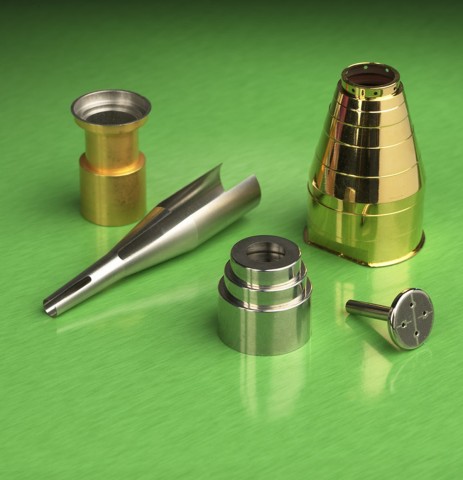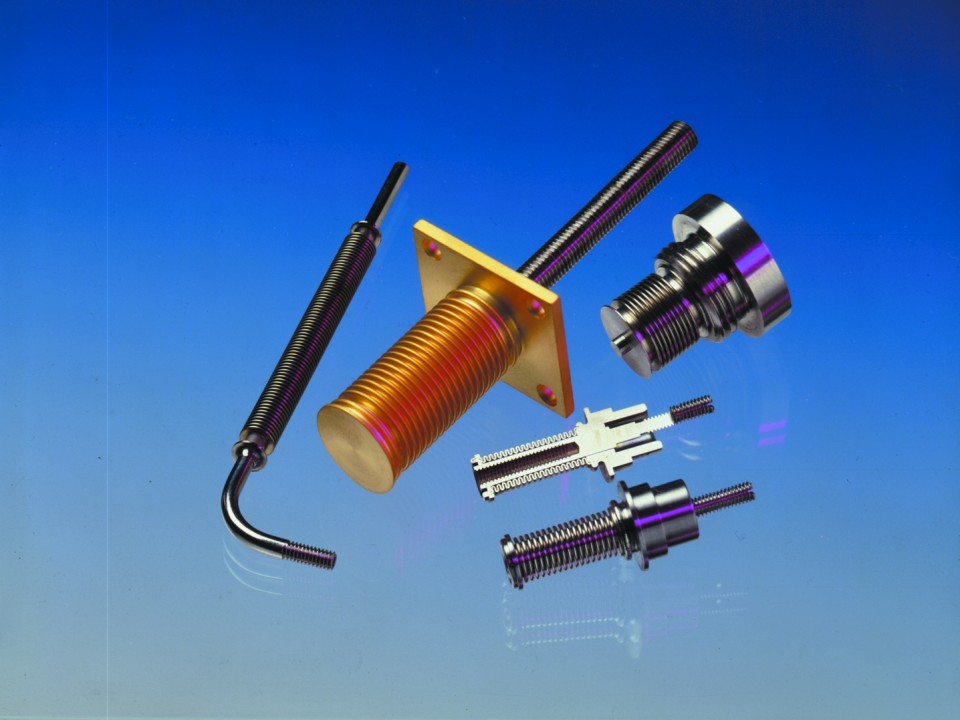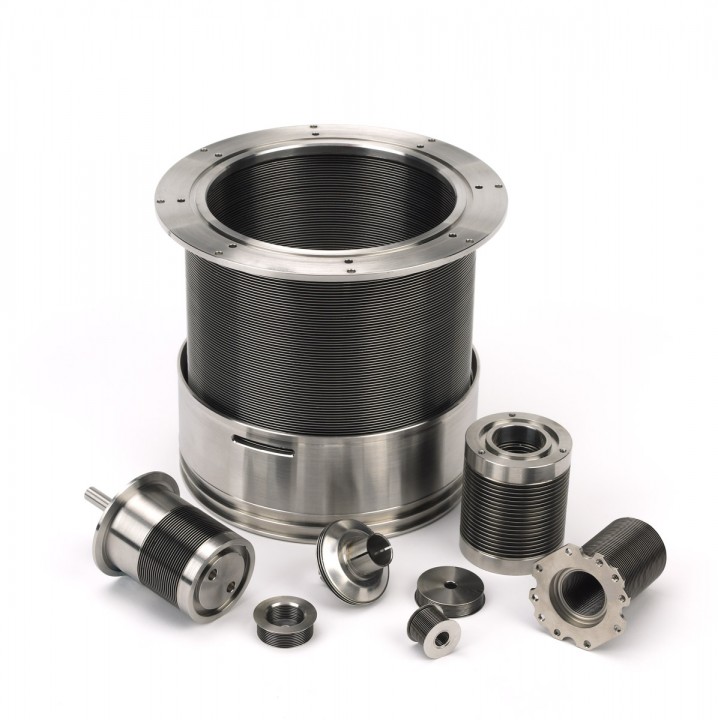

The versatile metal bellows play an essential role in controlling pressure, vacuum and motion, in a broad array of machine components and assemblies across numerous industry sectors.
The process begins with a piece of aluminium stock or bar. Next the internal geometry of the electroform is machined into the aluminium to produce a mandrel. After inspection, nickel, copper, gold, silver or combinations thereof are electrodeposited onto the mandrel to a precise wall thickness. Following a post plate inspection, the plated mandrel is trimmed to produce the desired end configuration and dimensions. Finally, the aluminium mandrel is then dissolved in a caustic solution leaving behind the completed electroform. At this point special finishes or coatings may be applied.
Metal bellows are flexible, spring-like, precision engineered components that are typically custom designed to perform a variety of engineering purposes. They can also be used in flexible electronic contact applications.
Specifically, precision-engineered metal bellows convert pressure, mechanical, vacuum and temperature changes into linear or rotational motion. While the metal bellows itself is typically just one small part of the overall machine assembly, it plays a critical role in the overall functionality of the system. Bellows provide a specifically defined dynamic response as part of a larger machine component or assembly - in some cases providing a more precise, more reliable or less costly alternative to an existing engineering solution.
Today’s advanced manufacturing techniques allow metal bellows to be precision engineered and manufactured with extremely small dimensions. For example, metal bellows can be manufactured with diameters ranging from 0.51mm to 228.6mm., walls as thin as 0.0051mm, and spring rates that can be controlled to +/-10%.
This whitepaper showcases some of the many engineering applications that can benefit from the use of metal bellows, and demonstrates the broad functionality of metal bellows in different engineering scenarios. It also provides engineers with a good working knowledge of the important specifications (in terms of requirements and restrictions) that must be considered for the application at hand.
Applications to date include, but are not limited to, the following market places:
Metal bellows provide essential engineering functionality in a vast spectrum of components and applications; some of these are discussed in greater detail below:
In fact, metal bellows are so reliable that they are also widely used as mechanical backups for mission-critical electronic systems.
Form and function
A metal bellows has the physical form of a flexible, lightweight, spring-like accordion (with the appearance of ribbed or corrugated tubing). In both vacuum and pressure applications, bellows are fabricated as part of a sealed, leak-tight assembly, with appropriate ends to allow connection within the equipment itself.
In many engineering applications, the bellows functions like a spring. But when it is filled with a pressurized liquid or gas, or subject to vacuum conditions, the bellows will be extremely sensitive to a variety of forces (such as pressure or temperature change) impacting the hydraulic fluid or gas sealed inside or outside the bellows. Since the coefficient of expansion of the fluid or gas is known, the bellows is designed to provide a predictable, dynamic mechanical response in response to these forces. Typically, the compression and extension of the spring-like bellows provides a predictable, dynamic linear response along its long axis (axial stroke motion), thus performing some engineering function within the machine component or assembly. While bellows are designed to be flexible in the axial direction (in terms of expansion and compression), they may also experience some lateral or angular offset during operation. This motion can be exploited to accommodate real-world machine operation (for instance, a bellows may be used as a flexible conduit or rotational link between two machine components). In some cases, such flexibility is intended as part of the machine design; in others, it is just fortunate that the bellows are “forgiving” in their ability to accommodate some unintended misalignment during operation due to tolerance build-up. As noted, metal bellows are widely used as a key enabling technology in many engineering applications. The major categories are described here, organized by the function the bellows performs.
Primary engineering applications
1a. Mechanical actuation
When metal bellows are sealed and filled with a known fluid (typically a silicone- based fluid), the bellows will compress or extend as the temperature changes. For instance, hydraulic fluid sealed inside the bellows (or fluid acting on the outside of a sealed bellows) will experience volume changes in response to rising or falling temperatures, and this change in fluid volume will be translated into linear movement along the main axis. By manipulating temperature to produce a predictable response, the bellows can then be used to provide precision positioning inside a machine assembly. Thin-walled bellows remain flexible within their full range of motion with no compromise in stroke even under cryogenic conditions.
In such low-temperature operations, bellows maintain their integrity and will not crack, thus, they provide reliable compression, extension, rotation, offset and coupling capabilities. For example, they are used as pumps for liquid nitrogen, or in space valve applications with liquid oxygen and have even been used with liquid helium.
Metal bellows are also used as indicators of pressure and temperature, as a result of the thermal expansion of the concealed fluid. Bellows are used in navigation and even missile technology, where low-temperature operations are critical. Bellows are also used in astronomy applications, to precisely cool and position mirrors.
1b. Actuation based on pressure changes
Similar to the thermal-activation mechanism described above, pressure changes can be used to control compression or expansion of the bellows to carry out some desired mechanical actuation activity. Specifically, as the bellows experiences changes in altitude or other pressure changes, and the surrounding sealed atmosphere experiences higher or lower pressure, the length of the bellows will respond in a predictable fashion, providing pressure-based actuation or pressure indication. One simple example is a system that relies on a bellows to activate a switch as a function of changing pressure. In this instance, the bellows expands incrementally as the pressure is rising, actuating a switch at a given pressure, or acting as a valve actuator to open or close fluid pathways.
Meanwhile, an aneroid is a bellows that has been evacuated and/or filled with a known gas and then sealed. The resulting system reacts to changes in ambient pressure, providing a desired mechanical response, or an indication of elevation. For example, bellows are used in aviation or aerospace devices that need to respond to the lower atmospheric pressures associated with rising altitudes. One aerospace example is the use of a bellows in an airplane, where the bellows actuates the closing of a particular valve as the airplane reaches a specified altitude.
Similarly, aneroids can be used to relieve pressure, equalize pressure, or maintain valve position as altitude changes. Bellows are particularly valued in aerospace applications because they provide a lightweight, reliable and elegant alternative to electronic actuators in many applications.
Metal bellows are superior to pistons in many pressure-based actuation applications, as they provide a hermetic seal by design; thus there are no seals to maintain or replace. Similarly, in many machine assemblies, bellows outperform conventional diaphragms, in terms of flexibility and travel length.
2.Actuation based on flexible rotational indication
Metal bellows are useful for their intrinsic characteristics - among them their ability to be both lightweight and rotationally rigid while remaining flexible along their primary axis. When the two ends of a bellows are joined to shafts that are misaligned or subject to changes in linear, radial or angular position from each other, the bellows can function as a coupling and can provide rotational indication (as feedback). The shape of the bellows allows for very efficient transfer of rotational energy without typical issues associated with couplings such as backlash. This is of particular use when implemented in precision machinery, such as encoders, where rotational accuracy is para- mount.
“Bellows are useful for their intrinsic characteristics - among them their ability to be both lightweight and rotationally rigid...”
3. Positive displacement pumps
Since a bellows can be a sealed flexible member, it can also function as a positive-displacement pump to move a liquid or gas through piping. Typically, a cam-lobe pushes against a shaft attached to the bellows to displace the fluid volume. A hermetically sealed bellows provides no frictional loss of power, which means that they are very efficient at providing pressure. The pump must overcome the spring rate of the bellows, but all of the remaining energy transfers directly into the fluid, and they can be used to produce steady or pulsating flow. In some cases, they can be used in place of piston pumps and diaphragm pumps. This application is typically reserved for smaller, relatively low-pressure pumping applications, and it is another example that works well under cryogenic conditions (for instance, for the pumping of liquid nitrogen). In some applications, the bellows may be able to get more volume per effective area compared to a diaphragm pump with a similar design
“A hermetically sealed bellows provides no frictional loss of power...”
4. Valves
Bellows work well in some valve applications (typically gate valves), to prevent stem leakage without the need for packing or O-rings. In such applications, the bellows provides a seal on the stem, so as the gate moves, the bellows expands or contracts to keep fluids from leaking out of the stem. Two examples include pressure-relief valves for overpressure in fuel systems, and inlet valves for transferring hazardous fluids (both of which have very low tolerance for fluid leakage). Similarly, in valve applications involving cryogenic fluids, the use of a bellows can ensure a hermetic seal (while packing and O-rings may be susceptible to shrinkage under those extremely low temperatures).
5. Volume compensation / fluid power applications.
Bellows serve multiple roles in these applications. For instance, they can be used as hydraulic dampeners (to bridge the gap between two shafts or hoses and dampen the impact of vibration between them), as flexible seals to allow for the adjustment of the dampening rate, and as volume compensators to alleviate temperature-related volume changes in a fluid. Cryo- genic volume compensation is a typical example. Bellows can often provide a better solution to venting an overpressure or high-pressure situation to the atmosphere.
5. Mechanical seals
Thanks to their flexibility and ability to compress or extend in a predictable way in response to pressure or temperature changes, bellows can function as flexible seals or metal membranes to seal shafts that rotate or move in an axial direction. A bellows may be used to seal a shaft on an actuator to prevent contamination from scoring the shaft and thus provide prolonged operational life.
“A bellows may be used to seal a shaft on an actuator to prevent contamination...”
6. Electrical Contacts
The metallic construction of the bellows provides good electrical conductivity. Metal bellows provide a useful function in contact assemblies that transmit a small current and deliver a defined force against the opposing contact surface. A bellows provides a sensitive, reliable mechanism, which will start conducting electricity as soon as it touches the opposing surface.
By comparison, a pogo pin (a spring-loaded pin inside a sleeve) requires much more compression before it starts to conduct electricity. Similarly, a bellows in a contact assembly can withstand vibration, angular offset or displacement better than a pogo pin, and bellows can be made in any size.
Primary manufacturing techniques
In general, metal bellows are produced using one of three main techniques those being electrodeposition (also called electroforming), edge welding and hydroforming. Each technique has certain advantages and disadvantages. In terms of the materials that can be used and also the bellows dimensions it is able to manufacture, and the performance characteristics and engineering capabilities of the finished bellows it can produce. Among these manufacturing techniques, electrodeposition and edge welding are discussed below, since these two techniques offer demonstrable advantages over hydroforming (A process that is beyond the scope of this article).
Electrodeposited / Electroformed bellow

Electrodeposited bellows are extremely rugged and lightweight. They are produced by plating metal (most often nickel, copper, gold and silver or a combination of these) onto a precision-machined, bellows-shaped form or aluminum mandrel. The edges are trimmed, and the mandrel is chemically dissolved. Silver, copper and gold are also available as surface finishes if needed, to reduce corrosion risk or improve media compatibility.
This electrodepostion process allows the manufacture of bellows with precisely controlled wall thickness (as thin as 0.0051mm), and with the smallest possible diameters (as small as 0.051mm). At these dimensions, the resulting tiny bellows are extremely sensitive — up to 25 times more sensitive than hydroformed bellows — and thus are able to provide very large deflections in response to the application of very small forces (as small as 4 grams).
Some key attributes of electrodeposited bellows are:
Edge welded bellows

By comparison, edge-welded bellows can be made from more than a dozen materials (including Stainless Steel, Inconel, Hastelloy®, titanium and many others). They are produced by welding metal diaphragms that have been stamped from strip material, stacked together and welded, (ID to ID then OD to OD) using plasma, laser, arc or electron-beam welding (the welding technique is selected as a function of the material).
Edge-welded bellows can be manufactured in diameters from 9.5mm up to 558mm and larger diameters can be custom-engineered, with wall thicknesses from 0.051mm to 0.300mm. (depending on the material used). In addition, double-walled bellows can be produced, allowing for higher operating pressures without having as high a spring rate as a single walled bellows with the same thickness.
Some key attributes of edge-welded bellows are:
Engineering considerations during bellows specifications
The following guidelines help determine the appropriate manufacturing technology for the bellows as well as the required performance specifications for the application.
The most appropriate manufacturing technique for the bellows (electrodeposition versus edge welding) is determined by specific requirements and constraints of the application, in terms of critical dimensions, material compatibility with the process environment, cleaning requirements, and more. The ability to clearly articulate all of these key attributes in the bellows specifications will ensure success.
In one particular surgical application, a bellows is used to provide a hermetic seal between two parts that move linearly with respect to each other. In this application, the customised bellows also had to resist torsional loading and was energized with a high voltage, high frequency signal. As a surgical application, the bellows needed to be biocompatible as well as survive the heat and pressure of auto claving, so it was supplied gold-plated. In another application, a bellows is used to seal off an actuating rod to separate machine fluids from food-related fluids.
Key dimensional requirements
While off-the-shelf bellows are available in a range of sizes, materials and configurations, bellows are most often custom-engineered, to ensure proper operation. Before the ‘perfect’ bellows can be configured, a variety of design factors, such as pressure, stroke, spring rate and effective area, must be considered. This list summarizes some of the important considerations to be discussed with the bellows design team.
Key performance requirements
Further product details can be found here
